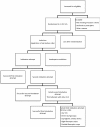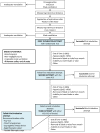SWIVIT--Swiss video-intubation trial evaluating video-laryngoscopes in a simulated difficult airway scenario: study protocol for a multicenter prospective randomized controlled trial in Switzerland
- PMID: 23556410
- PMCID: PMC3651724
- DOI: 10.1186/1745-6215-14-94
SWIVIT--Swiss video-intubation trial evaluating video-laryngoscopes in a simulated difficult airway scenario: study protocol for a multicenter prospective randomized controlled trial in Switzerland
Abstract
Background: Video-laryngoscopes are marketed for intubation in difficult airway management. They provide a better view of the larynx and may facilitate tracheal intubation, but there is no adequately powered study comparing different types of video-laryngoscopes in a difficult airway scenario or in a simulated difficult airway situation.
Methods/design: The objective of this trial is to evaluate and to compare the clinical performance of three video-laryngoscopes with a guiding channel for intubation (Airtraq™, A. P. Advance™, King Vision™) and three video-laryngoscopes without an integrated tracheal tube guidance (C-MAC™, GlideScope™, McGrath™) in a simulated difficult airway situation in surgical patients. The working hypothesis is that each video-laryngoscope provides at least a 90% first intubation success rate (lower limit of the 95% confidence interval >0.9). It is a prospective, patient-blinded, multicenter, randomized controlled trial in 720 patients who are scheduled for elective surgery under general anesthesia, requiring tracheal intubation at one of the three participating hospitals. A difficult airway will be created using an extrication collar and taping the patients' head on the operating table to substantially reduce mouth opening and to minimize neck movement. Tracheal intubation will be performed with the help of one of the six devices according to randomization. Insertion success, time necessary for intubation, Cormack-Lehane grade and percentage of glottic opening (POGO) score at laryngoscopy, optimization maneuvers required to aid tracheal intubation, adverse events and technical problems will be recorded. Primary outcome is intubation success at first attempt.
Discussion: We will simulate the difficult airway and evaluate different video-laryngoscopes in this highly realistic and clinically challenging scenario, independently from manufacturers of the devices. Because of the sufficiently powered multicenter design this study will deliver important and cutting-edge results that will help clinicians decide which device to use for intubation of the expected and unexpected difficult airway.
Trial registration: NCT01692535.
Figures
Similar articles
-
Evaluation of six videolaryngoscopes in 720 patients with a simulated difficult airway: a multicentre randomized controlled trial.Br J Anaesth. 2016 May;116(5):670-9. doi: 10.1093/bja/aew058. Br J Anaesth. 2016. PMID: 27106971 Clinical Trial.
-
Comparison of three video laryngoscopy devices to direct laryngoscopy for intubating obese patients: a randomized controlled trial.J Clin Anesth. 2016 Jun;31:71-7. doi: 10.1016/j.jclinane.2015.12.042. Epub 2016 Mar 23. J Clin Anesth. 2016. PMID: 27185681 Clinical Trial.
-
Comparison of the C-MAC video laryngoscope to a flexible fiberoptic scope for intubation with cervical spine immobilization.J Clin Anesth. 2016 Jun;31:46-52. doi: 10.1016/j.jclinane.2015.12.045. Epub 2016 Mar 22. J Clin Anesth. 2016. PMID: 27185677 Clinical Trial.
-
Videolaryngoscope designs for tracheal intubation in adults: a systematic review with network meta-analysis of randomised controlled trials.Anaesthesia. 2025 Jul;80(7):823-833. doi: 10.1111/anae.16597. Epub 2025 Mar 11. Anaesthesia. 2025. PMID: 40069118
-
Efficacy and safety of videolaryngoscopy versus direct laryngoscopy in paediatric intubation: A meta-analysis of 27 randomized controlled trials.J Clin Anesth. 2020 Nov;66:109968. doi: 10.1016/j.jclinane.2020.109968. Epub 2020 Jul 6. J Clin Anesth. 2020. PMID: 32645564
Cited by
-
Comparison of the intubation success rate between the intubating catheter and videolaryngoscope in difficult airways: a prospective randomized trial.Braz J Anesthesiol. 2022 Jan-Feb;72(1):55-62. doi: 10.1016/j.bjane.2021.04.027. Epub 2021 May 12. Braz J Anesthesiol. 2022. PMID: 33991552 Free PMC article. Clinical Trial.
-
Comparison of the McGrath videolaryngoscope and the Macintosh laryngoscope for double lumen endobronchial tube intubation in patients with manual in-line stabilization: A randomized controlled trial.Medicine (Baltimore). 2018 Mar;97(10):e0081. doi: 10.1097/MD.0000000000010081. Medicine (Baltimore). 2018. PMID: 29517671 Free PMC article. Clinical Trial.
-
A comparative randomized trial of intubation success in difficult intubation cases: the use of a Frova intubation catheter versus a Bonfils intubation fiberoscope.Wideochir Inne Tech Maloinwazyjne. 2019 Dec;14(4):486-494. doi: 10.5114/wiitm.2019.83610. Epub 2019 Mar 14. Wideochir Inne Tech Maloinwazyjne. 2019. PMID: 31908693 Free PMC article.
-
Apnoeic oxygenation with nasal cannula oxygen at different flow rates in anaesthetised patients: a study protocol for a non-inferiority randomised controlled trial.BMJ Open. 2019 Jul 11;9(7):e025442. doi: 10.1136/bmjopen-2018-025442. BMJ Open. 2019. PMID: 31300494 Free PMC article.
-
Comparison between Glidescope and Lightwand for tracheal intubation in patients with a simulated difficult airway.Korean J Anesthesiol. 2015 Feb;68(1):22-6. doi: 10.4097/kjae.2015.68.1.22. Epub 2015 Jan 28. Korean J Anesthesiol. 2015. PMID: 25664151 Free PMC article.
References
Publication types
MeSH terms
Associated data
LinkOut - more resources
Full Text Sources
Other Literature Sources
Medical



